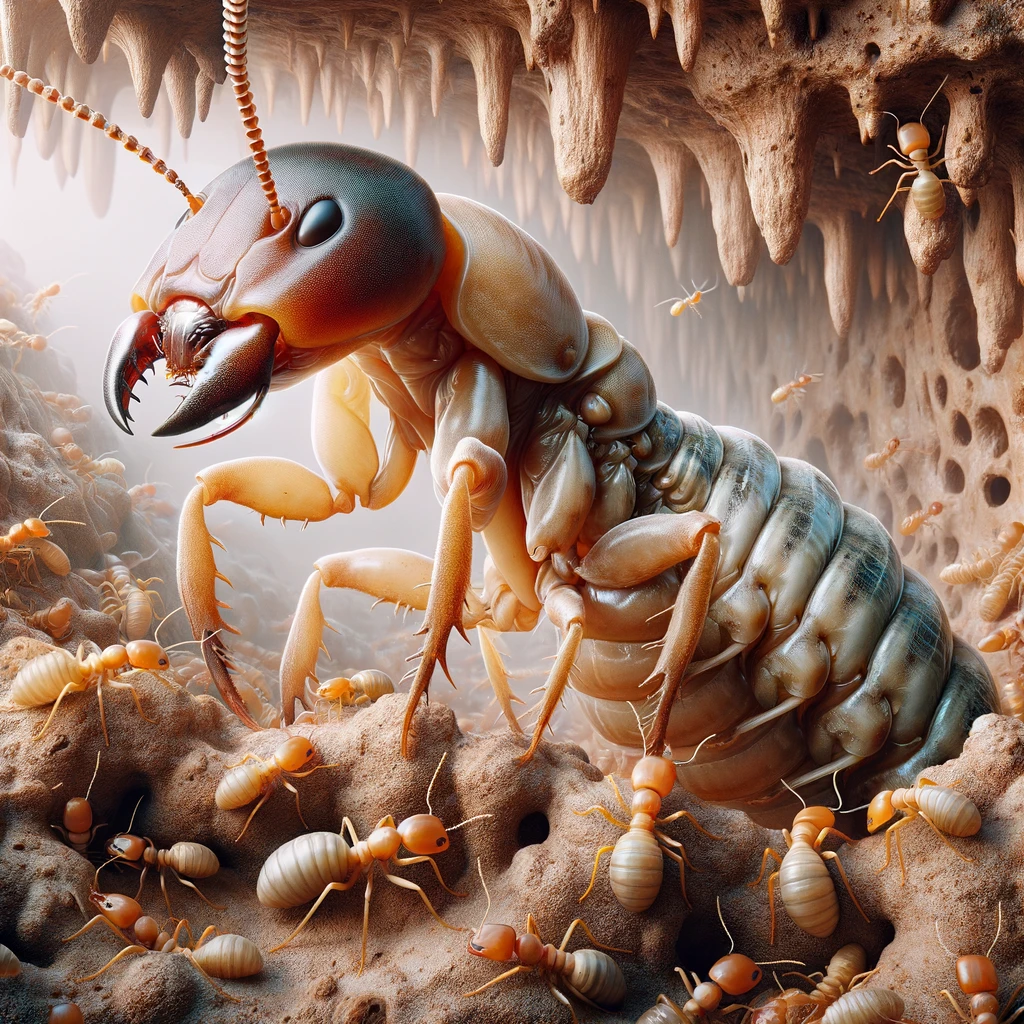
Termite Queen, Ruler of the Underground Empire
The tiny, but powerful creatures called termites live in a complex social structure, much like bees or ants. Each termite has a role to play in this busy world. But one termite stands out. It’s the termite queen. She is the star of the colony and runs the show her way. The queen is not just a termite, she’s an egg-laying machine that’s responsible for populating the colony. Imagine being responsible for populating an entire city. That’s what the queen does. She is not only important, but vital to the survival and expansion of her termite Kingdom. The colony would not survive without her. Next time you see termites, think about the queen who is behind the scenes making sure that everything runs smoothly.
Who is the Termite queen?
The termite colony’s social structure is complex, and the queen plays a crucial role. She is the center of her underground kingdom, not another insect. The primary task of the termite queen is to lay eggs. She does this amazingly well, laying thousands or even millions during her life, which ensures colony growth and survival.
The termite queen has a stunning physical appearance. She is much larger than the workers and soldiers, especially in her abdomen. This is to increase egg production. The swollen abdominal area makes her larger than the average worker termite or soldier. This stark contrast visually highlights her unique position in the colony.
The termite queen is the longest-living termite. The queen may reign for several decades, while workers and soldiers might only live a few years. Insect queens of some species have lived for more than 20 years. This is a remarkable feat. This prolonged lifespan is vital, as it allows the colony to grow steadily and for a longer period. She is a matriarch, not just a queen. Her presence ensures stability and continuity.
The Heart of the Hive – The Crucial Role of the Termite queen
The queen is of crucial importance in the complex world of termite colonies. The egg-laying is her primary duty and may be the most important for colony survival. The termite queen makes it an art, laying thousands and thousands of eggs every day. These eggs hatch to become the workers and soldiers who maintain and protect colony growth and stability.
The queen’s influence goes beyond the production of eggs. She is a master communicator in a way that we may find unusual. The queen of the termites uses powerful chemical signals called pheromones to control and influence her subordinates. These pheromones control the behavior and development in other termites and maintain a harmonious social structure. Her pheromones are so powerful that they can suppress the growth of other queens. This ensures her position as the only queen in the colony.
The queen’s relationship with her colony is a beautiful symbiotic one. The queen is the heart of the colony and ensures its future with her offspring. In return, the colony devotes itself to caring for her. Workers provide food, maintain the nest and defend against threats. This reciprocal relationship highlights the queen’s position as more than just a leader, but also a key component in a larger system. Her wellbeing is directly related to the prosperity of the colony, so her position as queen is not only one of power but also of responsibility and connection with her termite realm.
A Day in the life of a termite queen
A termite’s daily routine is fascinating and very focused. Her day revolves around her vital task of laying eggs. She is nestled deep inside the safest area of the colony. The queen’s egg-laying is not an ad hoc activity. She lays thousands of eggs every day in order to maintain the colony and ensure its growth.
The queen, despite her life of seclusion, is not isolated. She is constantly surrounded and attended to by workers termites. They feed her, groom and carefully remove the eggs from her to be nurtured in special chambers. She interacts with soldiers less frequently, since their primary responsibility is colony protection, but they play an important role in her safety.
The queen has a special and intimate relationship with the king. Since their nuptial flight together, the king has been the queen’s constant companion. He is vital to the colony, fertilizing the queen’s ovaries and at times helping with the young.
Although her life may seem monotonous, it is vital for the termite community. The queen’s every action and interaction is directed towards the survival and well-being her colony. The termite’s queen is a unique individual, whose life revolves around her role as a vital part of the colony.
The Pinnacle of the Colony – The Queen’s role in Reproduction
The role of the termite queen in reproduction is crucial to the colony’s expansion and existence. She is more than a mere figurehead. She is the main engine of the termite colony. She is only concerned with reproduction and performs it with astounding efficiency.
The queen’s journey to reproduce begins with her nuptial flight where she mates up with a king. The king is her lifelong partner, and he continuously fertilizes the eggs that she produces. The queen can lay up to thousands of eggs per day. This is a remarkable cycle, which ensures that the colony grows steadily.
The termite world is full of fascinating aspects, including the process of selecting new queens and their formation. When the colony grows to a certain size, or if the health of the queen is declining, some larvae will be nurtured and fed a special diet in order to become potential new queens. The larvae are then nurtured in a special way to develop into queens that can start new colonies. The species is maintained as the new queens will eventually fly to new colonies and establish them.
The queen’s entire life is dedicated towards the survival of her species. Her union with her king, and her incredible egg-laying ability are essential to the survival of her colony. She ensures the continuation of her rule far beyond her lifetime by nurturing potential successors.
Peril in the palace: threats to the Termite queen
The termite colony’s queen faces a number of natural and man-made challenges. Predators such as ants, small mammals, birds and other predators are often attracted to termite colonies. This poses a serious threat. Due to her vital role and inability to move, the queen is especially vulnerable. The colony can be destroyed if she is injured or removed.
Human activity adds another layer of danger. Urbanization and forest destruction destroy natural habitats. Pesticides and insecticides are also capable of decimating entire colonies. As humans continue to encroach on natural landscapes termite colonies face an increasingly difficult battle for survival. The intersection of natural predators and human impacts highlights the fragile equilibrium in which termite colonies exist.
Unveiling Mysteries: Fascinating facts about Termite Queens
Termite Queens have some amazing traits. They can live for up to 50-years, making them among the longest-living creatures. The typical termite has a life expectancy of just a few short years. A termite’s size can also be grotesque, due to the enlarged abdomen that makes her larger than any other colony member. This adaptation was made solely to maximize egg production. A termite queen can reproduce asexually under certain circumstances, which is a rare capability among eusocial insects. They can establish colonies without a King under certain conditions. This shows their adaptability and resilience. These characteristics highlight the queen’s crucial role within her colony as well as the ecosystem.
The Keystone of the Colony – Reflecting on the Role of the Termite Queen
The termite colony’s queen plays an important role not only within the colony but also in the ecosystem. Her constant egg-laying is responsible for the rapid growth of termite colonies, which contributes to soil airing and nutrient recycling. Understanding the role and life of termite queens helps to shed light on how nature works and the importance even of the smallest creatures for maintaining ecological harmony. This insight leads to a greater appreciation of the interdependences in our natural environment.
